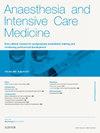Pathophysiology and treatment of COVID and its perioperative management
IF 0.3
Q4 ANESTHESIOLOGY
引用次数: 0
Abstract
The coronavirus disease 2019 (COVID-19) pandemic, caused by severe acute respiratory syndrome coronavirus 2 (SARS-CoV-2), has posed significant global challenges since 2019. Despite the subsequent emergence of the milder Omicron variant in November 2021, COVID-19 continues to cause significant morbidities and mortality, especially among the elderly and those with medical comorbidities. Its global impact necessitates a comprehensive understanding of its pathophysiology and management, particularly in perioperative settings. This review provides a comprehensive analysis of the pathophysiology and clinical features of acute COVID-19 and long COVID, current evidence-based treatment strategies and perioperative consideration. This review, tailored for anaesthetists and intensivists, emphasizes individualized care and multidisciplinary collaboration to improve outcomes of COVID-19 patients undergoing surgery.
新冠肺炎的病理生理、治疗及围手术期处理
2019年以来,由严重急性呼吸综合征冠状病毒2型(SARS-CoV-2)引起的2019年冠状病毒病(COVID-19)大流行给全球带来了重大挑战。尽管随后在2021年11月出现了较温和的欧米克隆变异,但COVID-19继续造成严重的发病率和死亡率,特别是在老年人和有医疗合并症的人群中。其全球影响需要全面了解其病理生理学和管理,特别是在围手术期。本文综述了急性COVID-19和长期COVID-19的病理生理和临床特征,目前循证治疗策略和围手术期注意事项。本综述为麻醉师和重症医师量身定制,强调个性化护理和多学科合作,以改善接受手术的COVID-19患者的预后。
本文章由计算机程序翻译,如有差异,请以英文原文为准。
求助全文
约1分钟内获得全文
求助全文
来源期刊

Anaesthesia and Intensive Care Medicine
ANESTHESIOLOGY-
CiteScore
0.50
自引率
0.00%
发文量
152
期刊介绍:
Anaesthesia and Intensive Care Medicine, an invaluable source of up-to-date information, with the curriculum of both the Primary and Final FRCA examinations covered over a three-year cycle. Published monthly this ever-updating text book will be an invaluable source for both trainee and experienced anaesthetists. The enthusiastic editorial board, under the guidance of two eminent and experienced series editors, ensures Anaesthesia and Intensive Care Medicine covers all the key topics in a comprehensive and authoritative manner. Articles now include learning objectives and eash issue features MCQs, facilitating self-directed learning and enabling readers at all levels to test their knowledge. Each issue is divided between basic scientific and clinical sections. The basic science articles include anatomy, physiology, pharmacology, physics and clinical measurement, while the clinical sections cover anaesthetic agents and techniques, assessment and perioperative management. Further sections cover audit, trials, statistics, ethical and legal medicine, and the management of acute and chronic pain.
 求助内容:
求助内容: 应助结果提醒方式:
应助结果提醒方式:


